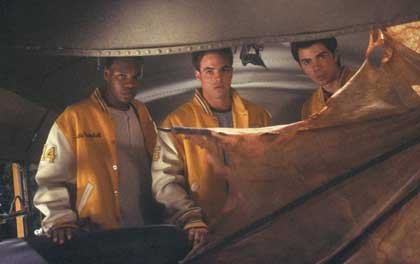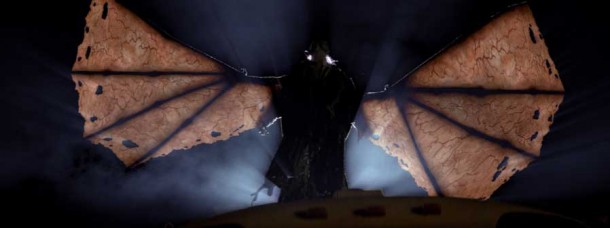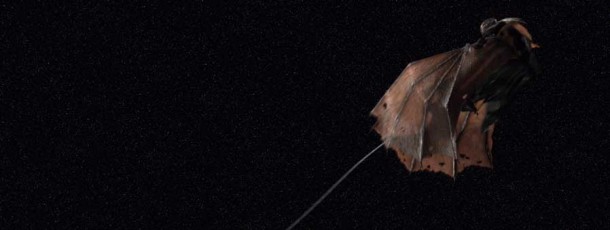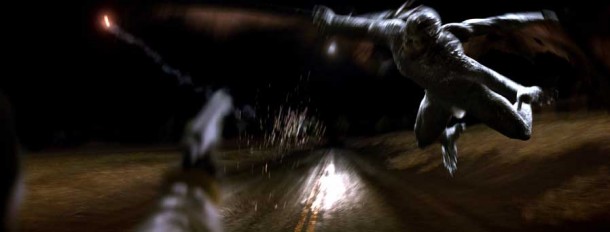“Digital Horror” on Jeepers Creepers 2
“Digital Horror”
CG Channel interviews Jonathan Rothbart at the Orphanage on the VFX of “Jeepers Creepers 2”
A busload of basketball players, their coaches and cheerleaders are served out as main course to the Jeepers, an ancient winged creature that feeds-off every 23 years on human flesh. That’s probably why the film is called “Jeepers Creepers”. Oh, and this is the second film with the title, so this would be “Jeepers Creepers 2”.
We had the chance to talk with Jonathan Rothbart from the Orphanage on the digital creepers they created, digital set extensions and most of the magic seen on-screen.
 CGC: This is our first interview on CG Channel; perhaps you could tell us what is the Orphanage?
CGC: This is our first interview on CG Channel; perhaps you could tell us what is the Orphanage?
JR: The Orphanage was founded in 1999 by myself and Scott Stewart. We left ILM because we wanted to have more control over the type of work we were doing. We wanted to build a place were we could create not just visual effects, but have an opportunity to develop and produce our own films. We started by creating a few short films. This is when Stu Maschwitz came on board. The three of us used the money we were making from visual effects jobs to finance the short films we were producing. We had some great success and had some films shown at the Sundance Film Festival. Since then we have groan to a facility with over one hundred people and a production development team in Los Angeles. Stu and I have stayed up here in San Francisco to continue the post-production work and Scott has moved down to L.A. Where he is working with Amy Isreal to head up the production side of the business.
CGC: So, if this is an Orphanage, what are the procedures for adoption?
JR: We are an Orphanage, so you must be unruly and have no parents.
No, having extremely talented artists is the number one priority here. Also, we feel that there is a unique culture at the company and it is important to maintain that culture. It is not for everyone, but the people who are here love the working style and enjoy being around all the other artists. People here just have a great time being together and collaborating to create awesome art.
CGC: Who is the producer?
JR: Luke O’Byrne. Luke was someone I had worked with back at ILM on one of my first shows (Dragonheart). He was a coordinator and I was working in the art department creating concept design and animatics. Luke is now our executive producer and oversees all the producers in house.
CGC: Your team is made up of several highly experienced team-members. How did past projects and the experience you gained on them helped you make the right decisions on this one?
JR: We have been building up different skill sets within the company over the past few years. We started out doing mainly Hard Surface Effects. Those would be things like trains, cars, planes, helicopters, etc… We then brought on Brian Flora, who was one of the senior Matte Painters at ILM. With the addition of Brian we were able to expand our digital Environment Division. Most recently we have grown the Digital Creature Department. It is headed by Rudy Grossman, another former ILMer. No, not everyone here is from ILM. It just seems that way some days. Rudy has done an unbelievable job in taking us into the cutting edge of digital creatures. Jeepers Creepers 2, was our first big creature show. This was a great opportunity for us. We had not created a digital character that was going to be shown so prominently in a film before. I think we did a good job making it work.
This was a fully digital creeper in front of a digital sky.
Since then we have created Digital Doubles for Charlie’s Angels, Spy Kids III and we are currently creating creatures for Hellboy. We have tried to grow incrementally and not too quickly. We wanted to find the right projects to make sure we did things correctly and created a foundation for us to continue to expand each area in the studio. Fortunately, on Hellboy, we are able to create effects in all of these areas, in addition to creating so amazing effects animation.
CGC: What was the original order you received from your client and how has this evolved during production?
JR: We had always been given the task of creating a digital Creeper. However, we ended up adding digital environments into the mix, along with some other effects that you see in most films these days.
CGC: To our knowledge, The Orphanage is the only credited CG FX house on the film Can you give us a breakdown of the work you did in the film?
JR: We had to create a fully digital Creeper for all the wide shots of when he was flying. We also had to create digital wings that needed to be extending from the Creepers back for the medium to tight shots. The wing shots proved to be more difficult then the fully CG Creeper shots. We had to match the wings seamlessly to the Creeper’s back. Kevin Baillie, our CG Supervisor did an amazing job of making the pipeline work. We could not have finished the show without his technical and artistic talent.
One of the effects we were not counting on having to do in the film was digital environments. But, when we started shooting the chase sequence on location we found that there wasn’t enough road. Also, the process trailer could not go fast enough to give the chase the intensity it needed. After discussing a number of ways to work with the existing footage, we decide it would just be easier to re-create the whole environment. When we were on set we thought it might be the case and took a ton of reference footage that made the job much easier. Ryan Tudhope ran all the digital environment shots and really made that whole sequence happen. He did a masterful job in making all the transitions seamless. I always get a kick out of these kinds of effects, because (hopefully) the audience has no idea they are there and it really lends itself to the story.
CGC: How did you design the wings of the character?
JR: The original designs were done by Brian Penikas. He created the Creepers costume and makeup. We started with his design and then did some research into bats, dinosaurs and other leathery type wings. We had to stay pretty consistent with the practical model as we had one particular shot on the bus where two wings cut back to back.
In this shot we created digital creeper wings that were revealed as his they spread from his back. This was a particularly tricky shot in that we had to figure out how it was be possible for the wings to expand, yet not be visible before they appeared beyond his coat. It involved a fair amount of creative rotoscoping to create a look that appeared natural. This is also the big shot where we really played off the translucent wings and created the heavy fog beams. This was also tricky in that we had to have the proper shadows and translucent look while the wings were in front of the creeper, but were lit up when they were hit by the direct light in front of him. – JR
CGC: What can you tell us about the texturing/lighting challenge?
JR: The wings were translucent. This created some very big challenges. Translucent skin is not the same as transparent and it reveals things behind it differently depending on the way the light is hitting wing. One of the most difficult shots was when the Creeper grabs one of the kids holding up his wing while he thinks the Creeper is dead. We cut from a shot of the kid holding up the practical wing to our digital wing, which then comes to life, wraps around the kid and then pulls him our of the bus. It came off really well.
The really cool thing about this shot is that we had originally shot a plate of the road that we intended to have the Digital Creeper flying over. However, when we were out on location we realized the length of road was too short and we could not get the process trailer moving fast enough. We ended up replacing the entire set with an exact digital representation that cut perfectly with the live action shots filmed with the talent. By doing this we were able to have more dynamic shots then we would have ever been able to film on location. We also needed to swap out the live action creeper with CG wings for a fully CG creeper in the middle of the shot. It created a pretty complex set of problems.- JR
CGC: Integration with the live-plates must also have been a challenge, how did you get around?
JR: This was not too bad on this film. We were able to be on set for all the plate photography and green screen shoots. This gave us a ton of control and we were able to get everything we needed. There are always a few shots in every show that really challenge you, but for the most part the plates worked very well. The director (Victor Salva) was great about giving us the time and latitude on set to get it right. He trusted us that when we said, “don’t worry, there will be a awesome looking creeper flying right down the road right there.” I got the feeling he thought we were crazy with some of the types of things we were shooting, but it all paid off in the end.
CGC: What is your typical production pipeline at The Orphanage?
JR: We have been modeling and animating our creatures in Maya. We then rendered in a program called Air. It is a renderman based render. We had a great relationship with the programmer and we helped develop some of the tools for the program and he was always great about getting us what we needed.
Our digital environments are created in StudioMax and we render them in Brazil. Jeepers was one of the first films tried with this pipeline and it was very successful. We are now using that pipeline on Hellboy.
Our compositing package of choice is After Effects. We really love AE as a compositing tool. Stu and I have been using it since the ILM days. I really like the layer based compositing that is in AE. It is pretty different then something you see in a program like Shake, which is more node based. We have developed a compositing system that we call extended linear space. This technique allows us to work with a much broader range of values and we are able to generate an extremely accurate film look.
CGC: You are also engaged on the production of “Hellboy”, that must keep you very busy?
JR: Very. I don’t sleep much, but I am really loving it. The artist here are so awesome and I have gotten a kick out of working with Guillermo. He is an amazing director and just a joy to be around. His vision for Hellboy, is pretty amazing. We are getting the opportunity to creating some incredible visuals. I guess I will just have to sleep in March.
Big thanks to Jonathan Rothbart who took the time to answer all our questions, and also, I want to thank everyone at BWR for their incredible patience and the hard work that made this story possible in the first place.
Related Links:




